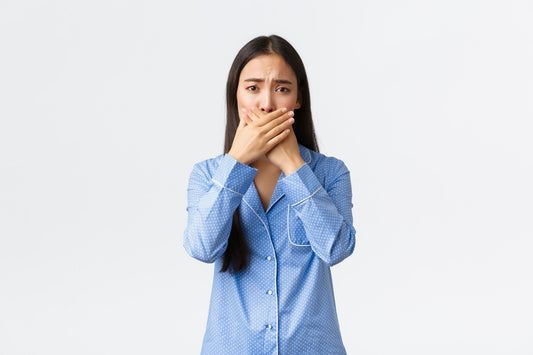The Complete Guide to Choosing the Right Toothpaste for Halitosis

The Complete Guide to Choosing the Right Toothpaste for Halitosis - Enzim Singapore
Halitosis, commonly known as chronic bad breath, is one of the most uncomfortable oral conditions adults experience. It affects over a quarter of the population worldwide and can create daily challenges, such as hesitating to speak closely, worrying about social situations, or overusing breath freshener sprays to mask mouth odour. Fortunately, most cases of halitosis can be improved by strengthening oral hygiene habits and selecting the right toothpaste for halitosis.
This article examines the causes of halitosis, the importance of toothpaste choice, and how to select the most effective toothpaste for combating bad breath, promoting long-term freshness and oral health.
1. Understanding Halitosis: Why It Happens
Many people assume bad breath comes from food alone, but persistent halitosis almost always begins inside the mouth. When food particles and proteins remain on the tongue or between the teeth, oral bacteria break them down and release volatile sulphur compounds (VSCs). These compounds are responsible for the distinctive, unpleasant smell associated with chronic bad breath.
Several oral health issues can worsen halitosis:
Gum Disease
When plaque buildup is not removed effectively, it hardens into tartar, triggering gum inflammation. Gum disease creates pockets that trap more bacteria, accelerating mouth odour.
Dry Mouth
Dry mouth reduces saliva production. Since saliva neutralises acids and washes away food particles, insufficient saliva leads to morning breath and persistent bad breath during the day.
Sensitive Teeth
People with sensitive teeth may brush lightly or avoid certain areas, allowing biofilm to accumulate and contribute to odour.
Tongue Coating
The tongue surface traps bacteria, producing up to 90% of odour-causing VSCs.
Lifestyle and Health Factors
Dehydration, stress, sinus infections, acid reflux, and certain medications can also contribute to halitosis.
With so many factors involved, the right toothpaste for halitosis is crucial for targeting multiple causes at once.
2. Why Toothpaste Matters in Halitosis Treatment
Toothpaste does far more than create foam or give temporary fresh breath. The right formulation helps manage the microbiological and chemical processes inside the mouth.
An effective toothpaste for halitosis should:
• Reduce odour-causing bacteria
Without disrupting the wider oral microbiome.
• Support saliva production
Essential for preventing dry mouth and encouraging fresh breath.
• Help prevent plaque buildup
This lowers the risk of gum disease and further odour.
• Strengthen enamel
Stronger enamel traps fewer food particles and contributes to healthier oral hygiene.
• Stay gentle on oral tissues
Especially for people with sensitive gums, sensitive teeth, or recurring mouth ulcers.
• Prevent long-term mouth odour
Not just mask it with mint flavour.
This is why choosing the best toothpaste for bad breath can make a meaningful difference to daily comfort and confidence.
3. Key Ingredients to Look for in Toothpaste for Halitosis
To identify the best toothpaste for bad breath, it’s important to understand which ingredients actively help reduce halitosis and promote long-term oral wellness.
A. Enzymes (The Gold Standard for Halitosis Toothpaste)
Enzyme-based formulations are among the most effective in supporting the mouth’s natural defences. The enzymes help reduce harmful bacteria without damaging beneficial microbes.
Common enzymes include:
-
Glucose oxidase
-
Amyloglucosidase
-
Lactoperoxidase
-
Lysozyme
-
Lactoferrin
These enzymes mimic and strengthen the body’s natural antibacterial processes, supporting saliva production and reducing mouth odour over time. This makes enzyme-based toothpaste one of the best choices when searching for toothpaste to help with bad breath.
B. SLS-Free Formulas
Sodium Lauryl Sulfate (SLS) is a common foaming agent, but it can irritate tissue, worsen dry mouth, and disrupt the oral microbiome. SLS-free formulas are gentler and safer for long-term use, especially for people trying to prevent halitosis.
C. Colostrum for Moisture and Gum Support
Colostrum contains natural growth factors and immune proteins that help support gum tissue, moisture balance, and overall oral hygiene. It's especially useful for people who experience dryness, sensitivity, or persistent mouth odour.
D. Potassium Nitrate for Sensitivity Relief
If sensitivity prevents proper brushing, more food particles and biofilm accumulate—leading to worse odour. Potassium nitrate helps soothe sensitivity so users can brush thoroughly.
E. Fluoride and Enamel Strengthening Minerals
Fluoride toothpaste helps with enamel strengthening, reducing the risk of cavities and plaque buildup—two major contributors to halitosis.
F. Zinc Compounds (Used Once Here)
Zinc chloride and zinc citrate can help neutralise VSCs. Although not essential for everyone, they offer short-term odour control in some whitening toothpaste and antibacterial toothpaste formulas.
4. Choosing the Best Toothpaste for Bad Breath: What to Consider
Different people require different types of toothpaste for halitosis depending on their lifestyle, oral health habits, and symptoms.
A. For Persistent Halitosis
Look for enzyme-powered, SLS-free formulations that regulate bacterial activity while supporting saliva.
B. For Morning Breath
A hydrating toothpaste—especially one containing enzyme systems and moisture-supporting proteins—can significantly reduce morning breath intensity.
C. For Dry Mouth
Dry mouth is one of the strongest predictors of ongoing halitosis. Moisturising toothpaste is essential.
D. For Sensitive Teeth
A formula containing potassium nitrate allows you to brush thoroughly without discomfort.
E. For People Seeking the Best Results
The best toothpaste for bad breath is usually the one that:
✓ supports oral hygiene
✓ reduces bacterial levels gently
✓ helps prevent tartar control issues
✓ supports enamel health
✓ manages dryness
✓ uses safe, food-grade ingredients
This combination creates the conditions needed for fresher breath.
5. Daily Routine for People Using Toothpaste for Halitosis
Selecting toothpaste to prevent bad breath is only part of the solution. A consistent routine helps maintain results.
Step 1: Brush Twice a Day with Enzyme-Based Toothpaste
Spend at least two minutes brushing. This helps reduce biofilm and food particles.
Step 2: Clean the Tongue
Using a tongue scraper helps remove biofilm responsible for mouth odour.
Step 3: Floss Daily
This prevents plaque buildup and dental issues that worsen odour.
Step 4: Hydrate Throughout the Day
Dehydration directly contributes to bad breath.
Step 5: Check for Oral Health Issues
Regular dental checkups help identify gum disease, enamel problems, or other underlying causes.
6. Recommended Toothpaste for Halitosis: Understanding Enzim’s Formulations
Enzim offers two powerful enzyme-based formulations suitable for people searching for toothpaste to get rid of bad breath, a good toothpaste for bad breath, or the best overall support for halitosis prevention.
Enzim Fresh Mint
This formulation offers:
✓ SLS-free, gentle cleansing
✓ Enzyme system for odour management
✓ Mint flavour without irritation
✓ Support for the oral microbiome
✓ Relief for recurring mouth ulcers
✓ Halal certification and cruelty-free standards
It is an excellent everyday toothpaste for bad breath and ideal for adults of all ages.
Enzim 40 PLUS
Best for people with:
-
dry mouth
-
sensitive teeth
-
gum concerns
-
enamel wear
-
recurring irritation
Contains:
✓ Enzyme system
✓ Potassium nitrate
✓ Colostrum for moisture
✓ Vitamin E for healing
✓ Food-grade, safe ingredients
This formula is ideal for adults seeking the best toothpaste for bad breath with added sensitivity and moisture support.
7. Conclusion: Choosing the Most Effective Toothpaste for Halitosis
Halitosis can be uncomfortable, but managing it becomes much easier with the right oral hygiene habits and the right toothpaste for halitosis. Look for products that support the oral microbiome, prevent dry mouth, reduce plaque, and strengthen enamel. Enzyme-based, SLS-free formulations—such as Enzim Fresh Mint and Enzim 40+—naturally support long-term freshness and oral comfort.
Whether you're looking for toothpaste to help with bad breath, toothpaste to get rid of bad breath, toothpaste to prevent bad breath, or simply the best toothpaste for bad breath, choosing a gentle, scientifically backed formula is the key to restoring confidence and achieving lasting fresh breath.



